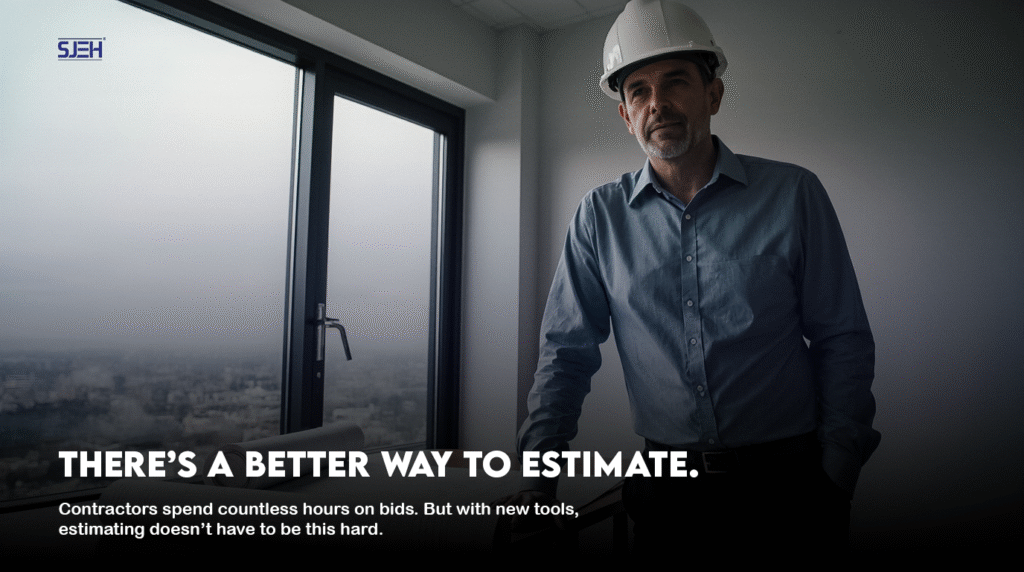Let me tell you about Sarah. She’s a sharp contractor who’s been running her own residential remodeling business for years. She’s great at what she does, but lately, a big chunk of her time has been eaten up by one thing: bidding.
Imagine a potential project, a full home renovation. To get the bid right, Sarah has to manually go through a massive set of blueprints, count every window, measure every wall, and calculate the square footage for flooring and drywall. She then has to call her suppliers for the latest prices and hope they do not change by the time she’s ready to order. It’s a grueling, hours-long process, and a single missed item or an outdated price can turn a profitable job into a money pit. The worst part? She might do this for five bids and only win one.
This is the reality for countless contractors. But what if there was a better way? What if a tool could handle all that tedious work in minutes, not days? This is where Artificial Intelligence (AI) for estimating comes in. It’s not some futuristic sci-fi concept; it’s a real tool being used by contractors right now. But is it right for you? Let’s break down the reality of using AI for estimating, looking at the good, the bad, and everything in between.

How AI is Changing the Estimating Game (The “Pro” Side)
Think of AI as your super-fast, incredibly detail-oriented intern who works 24/7 and never makes a simple math mistake. It’s designed to take the most labor-intensive parts of estimating and handle them for you.
Here’s how it works and what makes it so attractive:
1. Automated Takeoffs: From Days to Minutes
This is often the first step in estimating and a huge time sink. AI-powered software can take a PDF of your blueprints and, in seconds, automatically identify and count every element.
- How it works: Using computer vision, the AI “reads” your plans. It recognizes shapes and symbols, like a rectangle with an “A” for an air conditioning unit or a series of lines for a wall.
- The benefit: It will automatically measure the length of every wall, the area of every floor, and count every door, window, and light fixture. For a big project, a manual takeoff could take a full day. An AI can do it in ten minutes, giving you a comprehensive, itemized list of quantities. This alone frees you up to focus on the strategic parts of the bid.
2. Hyper-Accurate Cost Prediction
Ever lost a bid because you were too high, or worse, won one and lost money because you were too low? AI helps you hit that sweet spot.
- How it works: AI doesn’t just look at today’s prices. It connects to live databases and analyzes historical data, your past bids, material costs, labor rates, and even local market trends. It can predict how a project’s cost might fluctuate based on real-world factors.
- The benefit: This leads to incredibly precise estimates. Some contractors have reported seeing their accuracy jump by over 30%. This reduces the risk of costly overruns and helps you submit bids that are both competitive and profitable. It’s like having a financial advisor for every single job.
3. The Power of “What-If” Scenarios
Imagine being able to instantly see the cost difference of using different materials.
- How it works: With AI, you can change a single variable, say, swapping out standard drywall for a more expensive, fire-rated version. The AI instantly updates the entire estimate, showing you the new cost, profit margin, and how it impacts the bid.
- The benefit: This rapid analysis allows you to provide multiple options to your client, showing them how different choices affect the bottom line. It makes you look like a pro who is deeply in tune with their needs and budget.
Also Read: Construction Costs and the Economic Outlook in 2025: A Tale of Global and Domestic Forces
4. Increased Bid-Win Rates
Simply put, the faster and more accurate you can bid, the more bids you can submit.
- The benefit: By automating the mundane work, AI allows you to bid on more projects without sacrificing quality. This increases your chances of winning more work, which is the ultimate goal.
The Cautions and Challenges (The “Con” Side)
Sounds perfect, right? Well, just like any powerful tool, AI isn’t a silver bullet. There are real-world challenges to consider.
1. The “Garbage In, Garbage Out” Problem
AI is only as good as the data you give it. This is arguably the biggest hurdle.
- The challenge: If your past project data is messy, incomplete, or inconsistent, the AI won’t be able to learn effectively. It needs a clean, organized history of your previous jobs, costs, and materials to be truly accurate. For many small contractors, this means a lot of upfront work to get their “digital house in order.”
2. High Upfront Cost
Let’s be honest: good tech isn’t cheap.
- The challenge: The most powerful AI estimating platforms come with a significant price tag, both in software subscriptions and the time it takes to get everything set up. For a small contractor working on a tight budget, this initial investment can be a major barrier.
3. It’s a Co-Pilot, Not a Replacement
This is a crucial point. AI can’t replace human experience and judgment.
- The challenge: AI can’t drive to the job site, see that a tree needs to be removed, notice a cracked foundation, or have that crucial, trust-building conversation with a client. It can’t account for unforeseen complexities that come with unique projects. You still need to use your years of experience to review the AI’s estimate and make sure it makes sense in the real world. A contractor who blindly trusts the AI without verification is headed for trouble.
4. The Learning Curve and Employee Resistance
Change is hard, especially with new technology.
- The challenge: Getting your team on board can be difficult. Some employees may be hesitant or even worried about their jobs. They need to be trained on the new system, and that takes time and effort. The fear that a machine is coming to take over their role needs to be addressed with open communication and a focus on how AI will free them up for more rewarding, strategic work.
So, Should You Use AI?
The short answer is yes, you should absolutely consider it. But the real answer is more nuanced: start small and smart.
Think of it like this: you wouldn’t buy a $100,000 excavator for a job that only requires a shovel. Likewise, you don’t need the most expensive, all-in-one AI platform for your first dip into this technology.
My Advice:
- Start with a single, targeted AI tool. Instead of a full-suite system, try an AI-powered takeoff tool. Many are affordable and can be integrated with your current workflow. This is a low-risk way to see the value firsthand and get comfortable with the technology.
- Focus on one problem. Don’t try to automate your entire business overnight. Choose the one part of your estimating process that gives you the most headaches, maybe it’s takeoffs or staying up to date with material costs, and find an AI solution for that specific problem.
- See it as an advantage, not a threat. The goal isn’t to replace your team; it’s to make them better. AI handles the grunt work, allowing you and your team to use your expertise where it truly matters: building client relationships, managing complex challenges, and ensuring a project is completed perfectly.
The contractors who are embracing this technology today are the ones who will be leading the industry tomorrow. AI for estimating isn’t about replacing human skill; it’s about amplifying it. It’s about giving you back the most valuable resource you have: your time.
